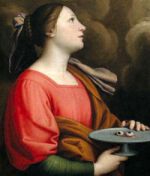Catholic Recipe: Saint Catherine's Wigs
"Sweet Saint Catherine, send me a husband, A good one, I pray; But arn a one better than narn a one. O Saint Catherine, give me your aid! Grant that I may never die an old maid!"
In such folk rhymes, unmarried girls of Dorset, England, once implored Saint Catherine, patroness of spinsters, to send them husbands. In those days girls were not too particular. Any husband was better than none!
Several chapels dedicated to Saint Catherine still stand on Dorset hilltops. Formerly, maids made pilgrimages to these shrines to petition their virgin saint. Legend claims that after Catherine was martyred in 307, at Alexandria, angels bore her body over the Red Sea and buried her on the summit of Mount Sinai. Supposedly this is why many sanctuaries to Saint Catherine occupy high places.
Since Saint Catherine is guardian of lace makers and spinners, as well as of spinsters, young girls and unmarried women in many industries once celebrated November 25, her anniversary, as their great holiday. Mumming, merrymaking, draughts of "hot pot" (warm rum-flavored beer, thickened with beaten eggs), and feasting characterized the day. In Bedfordshire, November 25 still is the "Lace Makers' Feast," and country folk continue to enjoy at least two traditional holiday foods-Kattern cake and wigs.
Kattern (Catherine) cake is made from bread dough, with ample additions of caraway, butter, eggs, and sugar, while wigs — also called wiggs, or wigges — are light caraway-flavored cakes or buns, made from fine white flour and molded into various shapes — round, oblong, or triangular — according to locality. In Bedfordshire they explain that the buns are called wigs because the batter, when poured into round tins and baked, "curls over the sides like the curls of a wig."
Often youngsters of five and up attended lace making schools. Ordinarily the pupils could not go home until they had finished their allotted stints. But on Saint Catherine's Day they had their freedom, as well as a tea with plenty of goodies and fun. Girls dressed up as boys and begged from farm to farm. In songs about Saint Catherine and Saint Clement, whose day is November 23, the children demanded apples, pennies, and hot pot. This custom was called "Catherning," "Catterning," or, in Worcestershire, "going Catten and Clementing."
Here is a typical begging carol:
"Catt'n and Clement comes year by year, Some of your apples and some of your beer, Some for Peter, some for Paul, Some for Him who made us all. Peter was a good old man, For his sake give us some; Some of the best and none of the worst, And God will send your souls to roost."
The concluding couplet alludes to climbing a ladder to fetch apples from the store loft, and to taking a can down cellar for beer:
"Up the ladder and down with the can, Give me red apples and I'll begone."
On "8th April, 1664," Samuel Pepys made this entry in his Diary: "Home to the only Lenten supper I have had of wiggs and ale." Why, not follow Mr. Pepys's excellent example and have wigs for your Lenten suppers — or better yet, for any meal, at any time of year?
DIRECTIONS
Combine yeast with lukewarm water and 2 tablespoons sugar. Stir and set aside for 15 minutes.
Scald milk, add butter and 1/2 cup sugar. Sift together flour, salt, and spices. When milk has cooled to lukewarm combine first mixture with the second. Stir and gradually add flour mixture, a little at a time. Stir well after each addition. Knead dough thoroughly and set aside to rise in greased covered bowl. When dough has doubled in bulk (approximately 2 hours) form into large flat buns. Place on greased baking sheet, brush tops with egg yolk beaten with 1 teaspoon cold water. Cut deep cross on each bun so the baked wig can be broken into quarters. Set to rise in warm place until doubled in bulk.
Bake in hot oven (400° F.) for 10 minutes. Then reduce heat to moderate (375° F.) and bake 10-15 minutes longer, or until thoroughly done inside and well browned outside.
Recipe Source: Feast-Day Cakes from Many Lands by Dorothy Gladys Spicer, Holt, Rinehart and Winston, 1960





